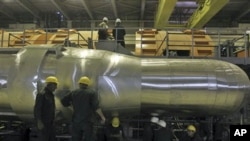Iranian media report workers have begun loading fuel into the core of the country's first nuclear power plant in the southern city of Bushehr. The process began in August, but was delayed due to a leak in a storage pool.
Top Iranian officials watched as fuel began being loaded into the Bushehr nuclear power plant Tuesday.
Repeated delays in completing the plant, followed by delays in putting it online have created embarrassment for the Iranian government.
The head of Iran's Atomic Energy Agency Ali Akbar Salehi spoke to Iranian TV says that today, Tuesday, marks the final stage in the start up process, as fuel is loaded into the reactor's core. He notes that the process is not finished, however, and that it could take two or three months to inject the full 163 fuel rods into the reactor.
Salehi also indicated that the plant probably won't be connected to Iran's national power grid until mid February. He claimed at the plant's inauguration in August that it would produce electricity by November.
Salehi's deputy, Mohammad Ahmadian, explained that a leak was partially to blame for the delay in completing the fuel injection process:
He says that the central pool of the reactor building was leaking and that the leakage needed to be localized and removed, prompting the delay.
Some press reports speculated that the plant's computers may also have become infected with the computer virus Stuxnet, creating havoc with its operating systems.
Russia, which built the plant, is providing it with nuclear fuel and will take back all spent fuel rods. Iran has also agreed to allow the International Atomic Energy Agency to monitor the process.
The U.S. and other Western states have given Russia the green light to launch Bushehr but oppose Iran's illicit enrichment of uranium at a plant in Natanz. Tehran insists Natanz is part of a civilian nuclear program, but the West fears it is part of a covert project to build nuclear weapons.
The European Union has invited Iran to resume negotiations over its nuclear program in Vienna, next month. Iranian President Mahmoud Ahmadinejad has welcomed the talks, but Tehran has not formally accepted the invitation.
|
Greg Thielmann of Arms Control Association comments on Iran's nuclear activities:
|
Iranian-born analyst Alex Vatanka of the Middle East Institute in Washington argues that the Bushehr plant is mostly a sideshow, involving Iranian prestige:
"Bushehr is not really considered as the most sensitive part of this standoff with the West," said Vatanka. "So, I don't really know why Bushehr, in this context of potential resumption of talks on the 15th of November, is in any way a critical issue. I look at it as the Iranians trying to say 'look, we have a success here.' Clearly, they can't point to the same degree of success or advancement on the enrichment of uranium. The centrifuges at Natanz are not working the way they should."
Iran recently announced that it has 30 kilograms of 20 percent grade highly enriched uranium, enough to produce atomic bombs, according to experts. Such Iranian claims continue to worry the West that Tehran is proceeding with a covert nuclear program.

